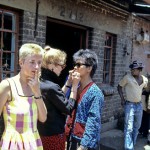
Born in South Africa, Rina Sherman was exiled from the country and settled in France in 1984 where she has been living and working since. A classical musician by training, she worked as independent theater actress and in television before turning to film making. In 1990 she completed a doctorate with distinction at the Sorbonne, supervised by Jean Rouch. Rina Sherman arrived on Jean Rouch’s doorstep at the French Cinémathèque with her film Chicken Movie. Cluck! under the arm. Rouch scrambled his screening program to include it and said: “It’s an urban poem, fresh, the kind of film we should be making today.” He later acted in some of Rina Sherman’s fiction and mixed genre films, of which An Egg With no Shell and M.M. les locataires.

Her first novel, UITREIS, (Leaving) was published in South Africa in 1997 to critical acclaim. Writer, filmmaker and anthropologist, Rina has initiated several cultural projects. She was audiovisual director for the exhibition “South Africa: Music of Freedom” at La Villette, 1995. That same year, she was awarded the prestigious French prize, “Villa Médicis Hors les Murs” that allowed her to undertake extensive research in the film archives of the Southern African region.
In 1996, she organized Jean Rouch’s tour of South African Universities in collaboration of the French Institute in South Africa (IFAS) and the Mission for Cooperation and Cultural Services of the French Embassy in Namibia.

In 1997 Rina was awarded a Lavoisier Research Bursary by the French Ministry of Foreign Affairs for the project “The Ovahimba Years“, a multidisciplinary long-term research program (video, film, photography, drawings, and oral tradition) aimed at creating a living trace of Ovahimba cultural heritage. For a period of seven years, she filmed, recorded and photographed aspects of the daily and ritual lives of the Ovahimba.
In 2002, she presented a multimedia exhibition, “The Ovahimba Years: Work in Progress“, at the Franco-Namibian Cultural Center in Windhoek. In 2003, she extended her research into the south-west of Angola, and has hence covered the entire Otjiherero sociolinguistic cultural heritage landscape. The project received support from the French Ministry of Foreign Affairs, various EU Embassies, The Ford Foundation and numerous private sponsors.
She is currently processing the data of her research and documentation results collected over a period of seven years in the field, writing and editing films about her years with the Ovahimba, as well as working toward the long term conservation of “The Ovahimba Years” Collection. In November 2011, a retrospective of Rina Sherman’s films was held at the Quai Branly Museum, with two programs, Life in the City and The Ovahimba Years.

Over the next two months we will be featuring work from Rina’s “The Ovahimba Years“. The Collection of the project “The Ovahimba Years” contains all of the data collected for numerous years by Rina Sherman on the Ovahimba and related populations of the Kunene Region, in north-western Namibia and the provinces of Cunene and the Namib in south-western Angola. It consists of images (film and video), sound recordings, drawings and photographs as well as a bibliography (copies of articles), texts and notes, correspondence, as well as administrative and production files, inventories and portfolios, covering the period from 1996 to present. Much of these elements covers daily and ritual life, and the history of the extended family of the late Headman of Etanga, heir to the throne held by the Tjambiru family for many generations.

Other elements are composed of information on the lives of family, friends and members of the surrounding community and other Ovahimba communities and related populations (Ovakuvale, Ovadhimba, Ovahakaona, Ovatwa, Ovacaroca, etc.) of Namibia and Angola. The documentation highlights the important role played by ritual dance and spirit calling ceremonies (trance). Several documents cover trials in customary law and important community meetings.
While Rina Sherman is continuing her work with the Ovahimba, she has also returned to her love for urban and mixed genre films, such as La poupée bleue, a film about life today in Montmartre, and she is has turned to portraiture with VOICES Meetings with Remarkable People a collection of filmed portraits, of which Jean Rouch’s accomplice and colleague, renowned Quebec filmmaker, Michel Brault. Next week on Tribal Truth we will be featuring a film from Rina’s “The Ovahimba Years” called When Visitors Come.







i knew you must have an interesting past, as your present is such. great stuff.
i knew you must have an interesting past, as your present is such. great stuff.
Rina, what a fabulous testimonial to a selfless life. I am proud to have met you.
I love the images you post on facebook.
Before this begins to sound like a crazed fan letter, I bid you farewell. Most interesting.
Merle.